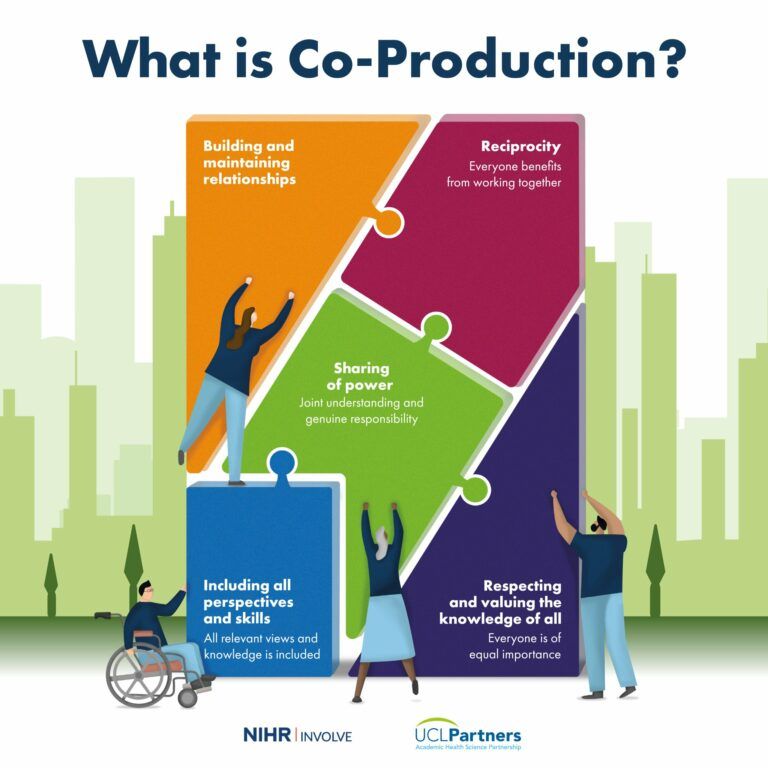What should co-production in health look like?
Co-production is simultaneously an activity, an approach and an ethos which involves members of staff, patients and the public working together, sharing power and responsibility across the entirely of a project.
In 2018 INVOLVE published guidance on how to co-produce a research project.
When Gary Hickey, of INVOLVE, presented the guidance at UCLPartners’ Involvement Leads Network meeting, a few of our patient colleagues commented that, while the document itself was excellent, it was not accessible. So we decided to co-produce an infographic based on the guidance.
This was something neither Gary, nor I, nor the designer, or our patient and public colleagues had ever done before. And we had no idea what we were doing – although it became a fundamental premise to the co-production that we could work this out together. Over two meetings and subsequent emails, we co-produced the following infographic:

The five principles of co-production apply to all co-production work – not just co-production in health research – and fit together like puzzle pieces, with diverse individuals needing to work together to put them all in place.
The Principles
Sharing of power
The group decided this was the central tenant of co-production. It is often difficult, due to institutional, and perhaps ashamedly personal, reasons to share power with patients and the public. However, genuine co-production means overcoming power imbalances. It means feeling a bit of discomfort, and pushing one’s own boundaries, to share power equally. With this infographic project, all of the people in the room – Gary, Ciara Mordaunt our designer, our patient and public colleagues, and I – had equal power and responsibility.
Reciprocity
I often reflect on how our patients and public colleagues benefit from getting involved in our work. While we have a payment policy and follow good practice set out by NHS England, INVOLVE and the Social Care Institute for Excellence for remuneration, there are many direct as well as indirect benefits for patients and the public: networking with other patients, learning more about health, getting exposed to other involvement opportunities, and a sense of contribution. For example, I am part of a national network of patient involvement and engagement leads across the academic health science networks (AHSNs). Each lead brings a patient or public colleague to our quarterly meetings. Through this, my patient partner has developed an interest in innovation in the NHS, and became involved in work of the NHS Innovation Accelerator.
Building and maintaining relationships
It cannot be understated that one of the key factors in PPIE is building and maintaining relationships. This can be difficult: we are not taught interpersonal skills past childhood. When my email inbox is bursting, the emails I respond to first are from those of our patient and public colleagues. I am still in touch with young people who I involved in a National Institute of Health Research study which finished two years ago. Through that work, one of the young people is now involved with the McPin Foundation and in a national group looking at involvement of children and young people in research, because she and I, and her mum, developed a special professional and personal rapport. And with this infographic work, the group were unanimous in our opinion that building and maintaining relationships are crucial for co-production.
Including all perspectives and skills
All individuals who come to a co-production task, be they patients, members of the public, or members of staff, have different backgrounds, and professional and personal experiences that will give them different perspectives. Patient colleagues develop expertise by experience of living with a condition. All of these different perspectives and skills add value to a co-production exercise.
Respecting and valuing the knowledge of all
As with any collaboration, it is paramount to respect and value everyone’s knowledge, including that of patient and public colleagues. In our Involvement Leads Network meetings at UCLPartners, we frequently have presentations from patients, in addition to presentations from staff from across our partnership. At our March meeting, we had a presentation about the NIHR Clinical Research Network Patient Research Ambassador initiative. We heard from Christine Menzies, the PPIE Manager for North Thames, and one of her patient colleagues about her experiences taking part in clinical trials, and her joy to have been offered the opportunity to take part in research.In co-producing this infographic, there was much discussion about the content and design. Where some of the patient colleagues or I lacked in creativity, Ciara’s skills and experience clearly shone through. Where patients had grand ideas about what was important to include in the infographic, as a group we decided we had to keep it simple. Where Gary or I had allegiances to our respective organisations, as a group we felt strongly that this is an infographic for anyone who wants to learn about co-production. And it was a delight to co-produce.